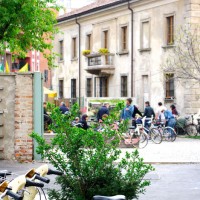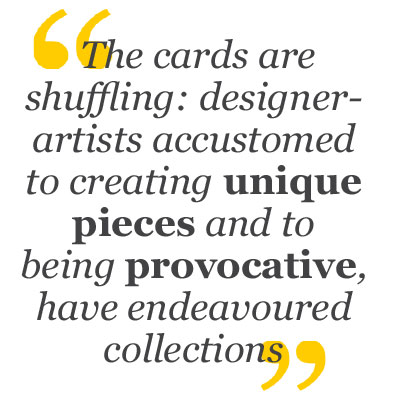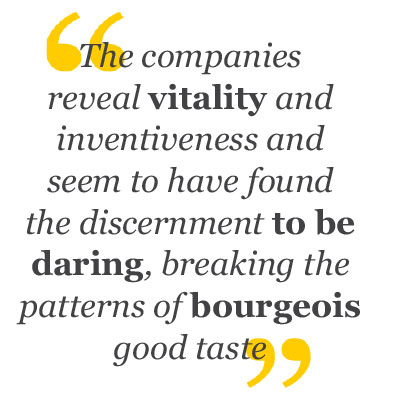
A Fuorisalone “Cuccagna”
9 April 2015
8 April 2015
The companies reveal vitality and inventiveness and seem to have found the discernment to be daring, breaking the patterns of bourgeois good taste, even with proposals bearing a slight touch of irony. The cards are shuffling: designer-artists accustomed to creating unique pieces and to being provocative, have endeavoured collections, as has, for example, Martino Gamper who designed for the historic Viennese company Gebrüder Thonet a series of chairs and stools, named Le Cirque, so named because of the acrobatic reinterpretations of the classic Viennese seats.
Alessandra Baldereschi reproduces for Seletti the tufted decoration on the painted iron outdoor seats.


Fiam continues its exploration on narcissism, augmenting its collection of large-scale mirrors with Ginevra, signed by Dante Benini and Luca Gonzo, which is a rectangular shape with a crumpled frame that seems modelled in silver paper.



Fernando and Humberto Campana embroided a chair in a signal colour by assembling metal strands for the International Brand A Lot Of Brasil, created by Pedro Paulo Franco. The brand, following its debut in 2013, exhibits in Milan its collection signed by well-known international designers. The manufacturer Fratelli Boffi, specializing in classic designs, has become firmly committed to the path of contemporary design and proposes a new type of seat, Parallell, high-backed, with a metal frame and upholstered in woven leather, similar to an “existens minimum” angled, suggesting a novel type of seat suitable for taking breaks to help one’s concentration.
The armchairs steal inspirations from fashion and feature backs modelled as wrapping collars (Gordon Guillaumier for Lema), or similar to corsets sealed by large pins (Bartoli Design for Kristalia). The sofas open out to become islands of comfort (Lounge by Calligaris and Summit by Giulio Iacchetti for Casamania).
Signal colours appear, as in, for example, the Olivia chair by Rexite. The Nordic designer abandons the look of natural wood and prefers polychrome (Charles Hansen) for his new chairs; while Artek relies on the Bouroullec brothers to make the workspace fluid. The large tables moreover suggest a return to conviviality (Leonardo by Fendi Casa, Corssby by Fattorini – Rizzini for Arper and Francesco Rota for Paola Lenti).

Cassina, an historic furnishing company known for its renditions of the great masters of the 1900s, targeted Spanish Jaime Hayon, known for his imaginative approach and his repertoire of bizarre porcelain figurines, for a new series of tray-stools in black painted wood, which seem like characters out of a comic opera, new in their figuration and typology. The bench, equipped with a handle and tray, becomes a practical and transportable coffee table, renewing the choreography of hospitality.








WHERE: Rho Fiera – Milano
The companies reveal vitality and inventiveness and seem to have found the discernment to be daring, breaking the patterns of bourgeois good taste, even with proposals bearing a slight touch of irony. The cards are shuffling: designer-artists accustomed to creating unique pieces and to being provocative, have endeavoured collections, as has, for example, Martino Gamper who designed for the historic Viennese company Gebrüder Thonet a series of chairs and stools, named Le Cirque, so named because of the acrobatic reinterpretations of the classic Viennese seats.
Alessandra Baldereschi reproduces for Seletti the tufted decoration on the painted iron outdoor seats.
Fiam continues its exploration on narcissism, augmenting its collection of large-scale mirrors with Ginevra, signed by Dante Benini and Luca Gonzo, which is a rectangular shape with a crumpled frame that seems modelled in silver paper.
Fernando and Humberto Campana embroided a chair in a signal colour by assembling metal strands for the International Brand A Lot Of Brasil, created by Pedro Paulo Franco. The brand, following its debut in 2013, exhibits in Milan its collection signed by well-known international designers. The manufacturer Fratelli Boffi, specializing in classic designs, has become firmly committed to the path of contemporary design and proposes a new type of seat, Parallell, high-backed, with a metal frame and upholstered in woven leather, similar to an “existens minimum” angled, suggesting a novel type of seat suitable for taking breaks to help one’s concentration.
The armchairs steal inspirations from fashion and feature backs modelled as wrapping collars (Gordon Guillaumier for Lema), or similar to corsets sealed by large pins (Bartoli Design for Kristalia). The sofas open out to become islands of comfort (Lounge by Calligaris and Summit by Giulio Iacchetti for Casamania).
Signal colours appear, as in, for example, the Olivia chair by Rexite. The Nordic designer abandons the look of natural wood and prefers polychrome (Charles Hansen) for his new chairs; while Artek relies on the Bouroullec brothers to make the workspace fluid. The large tables moreover suggest a return to conviviality (Leonardo by Fendi Casa, Corssby by Fattorini – Rizzini for Arper and Francesco Rota for Paola Lenti).
Cassina, an historic furnishing company known for its renditions of the great masters of the 1900s, targeted Spanish Jaime Hayon, known for his imaginative approach and his repertoire of bizarre porcelain figurines, for a new series of tray-stools in black painted wood, which seem like characters out of a comic opera, new in their figuration and typology. The bench, equipped with a handle and tray, becomes a practical and transportable coffee table, renewing the choreography of hospitality.
WHERE: Rho Fiera – Milano



The Moodboarders is a glance into the design world, which, in all of its facets, captures the extraordinary even within the routine. It is a measure of the times. It is an antenna sensitive enough to pick-up on budding trends, emerging talents and neglected aesthetics. Instead of essays, we use brief tales to tune into the rhythm of our world. We travelled for a year without stopping, and seeing as the memory of this journey has not faded, we have chosen to edit a printed copy. We eliminated anything episodic, ephemeral or fading, maintaining a variety of articles that flow, without losing the element of surprise, the events caught taking place, and the creations having just bloomed.